
With two commissions and several other projects on the go, it was tough to get traction this summer. I’m also spending a lot of time planning for the Banff Christmas markets that begin in November. As it spans four long weekends, I’ll soon need to figure out how much stock to order.
But first, there are two paintings I want to finish, so I’ll have them available for print and puzzles.
This week, the printed 18″ X24″ stretched canvas of a recently completed commission arrived. I’m delighted with how this painting turned out, and most importantly, so is the client. I’ll deliver it the first week of September when the client visits Canmore. After that, I look forward to sharing it with all of you.
The second commission is coming along nicely. 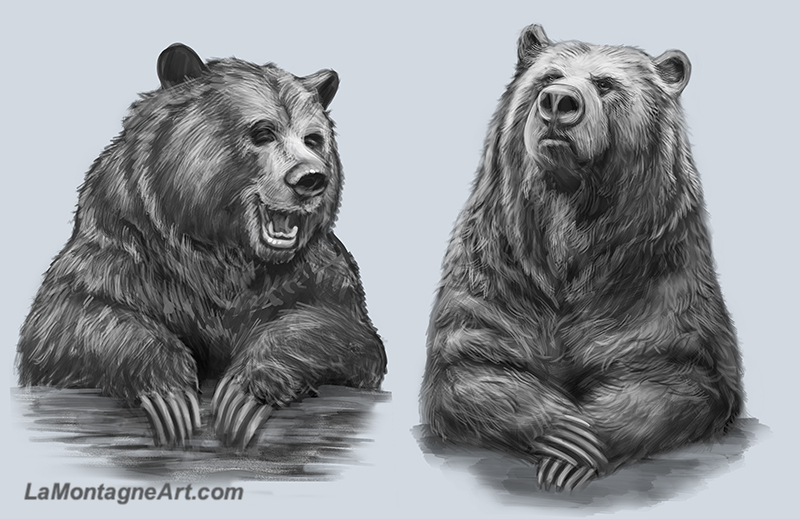 But I’ve also been working on the group of bears I’ve been chipping away at for some time now. The original plan for this piece was five adult bears sitting at a log in the woods, like a group of friends hanging out and chatting. I drew six of them separately to give myself options.
But I’ve also been working on the group of bears I’ve been chipping away at for some time now. The original plan for this piece was five adult bears sitting at a log in the woods, like a group of friends hanging out and chatting. I drew six of them separately to give myself options.
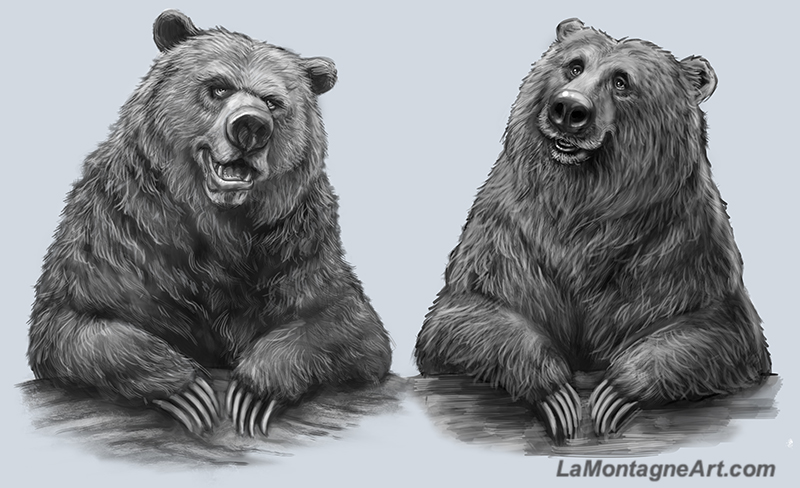 However, when I dropped and dragged them together into one image, the digital canvas was very long. A long horizontal canvas has appeal for a canvas or metal print. However, from a commercial perspective, it would limit what I could offer for licensing and paper prints.
However, when I dropped and dragged them together into one image, the digital canvas was very long. A long horizontal canvas has appeal for a canvas or metal print. However, from a commercial perspective, it would limit what I could offer for licensing and paper prints.
To make all five bears fit, with a bit of personal space between each, I’d need to compose them in a way that would leave a lot of space above and below. But that would make their faces much smaller, and I’d have to paint more foliage and background. Or I could stretch them vertically, but then they’d look far too distorted.
This is where working digitally is a blessing. While experimenting with each bear sketch, pushing and warping features, I soon realized another option for this painting. What if I made it a family of bears with older cubs, looking almost like teenagers?
Now, I know nature doesn’t work like this. The father is long gone by the time the cubs are born, which is good because he’d be a significant threat. As for Mom, she chases the cubs away at two or three years old.
I don’t paint reality.
It didn’t take long to fall for this new composition and abandon the old one. A family meant I could group them closer and have more fun with their expressions. Pushing, pulling and warping each of the sketched bears destroyed the initial sketched detail, but I probably would have had to do that for my original vision as well.
The sketches were just templates, and each contributed to this discovery.
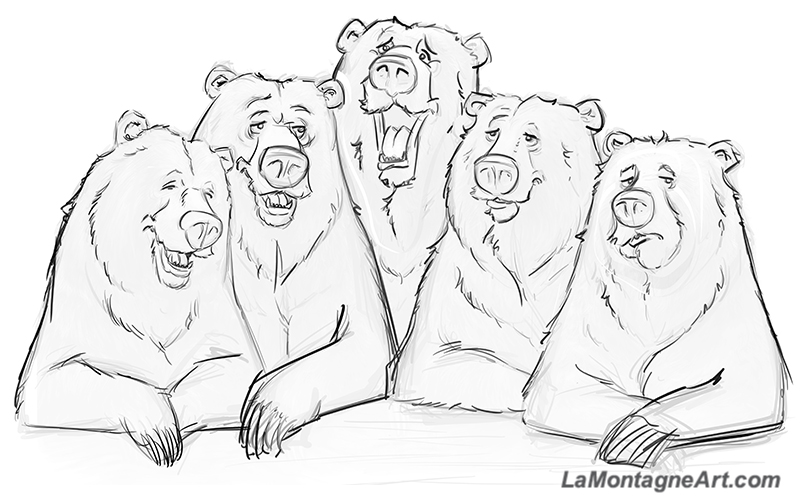 Once I was pleased with the group layout, I dropped the layer’s opacity and traced over the shapes and basic features. I did this several times, refining with each pass.
Once I was pleased with the group layout, I dropped the layer’s opacity and traced over the shapes and basic features. I did this several times, refining with each pass.
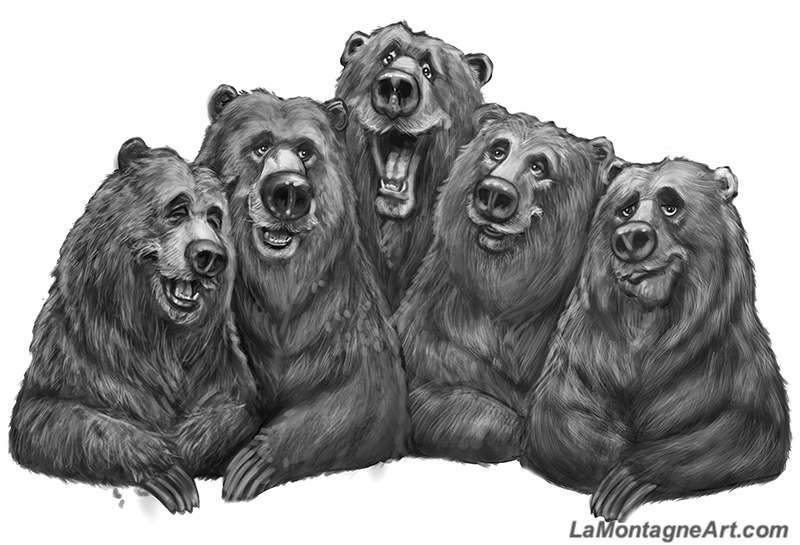 Then, I got to work on the shading, detail, expressions, and character. I do that right up until the end of every painting, as personality is the most essential part and is where I have the most fun. And with this painting, I’ve got five faces to discover instead of one.
Then, I got to work on the shading, detail, expressions, and character. I do that right up until the end of every painting, as personality is the most essential part and is where I have the most fun. And with this painting, I’ve got five faces to discover instead of one.
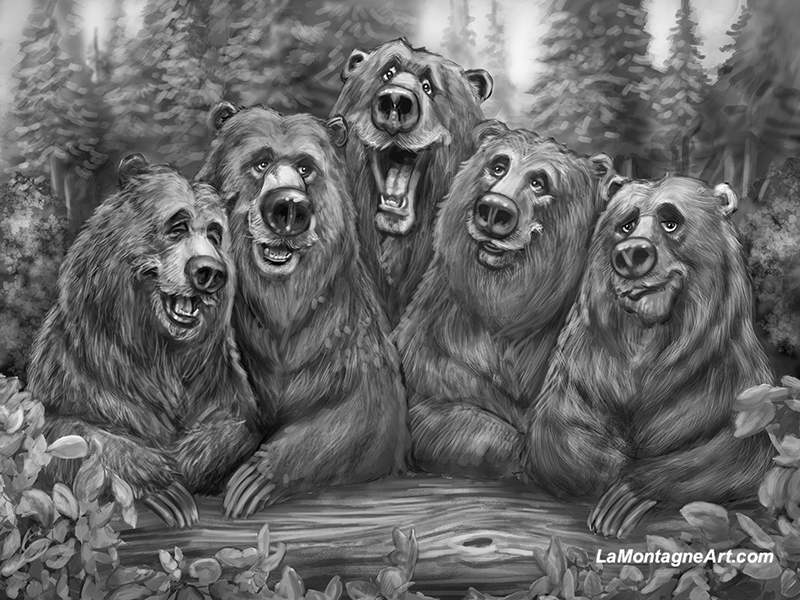 This piece seems like a family posing for a Sears portrait or the opening of a sitcom like Family Ties or Growing Pains. I’m going to call it ‘The Grizzlies.’
This piece seems like a family posing for a Sears portrait or the opening of a sitcom like Family Ties or Growing Pains. I’m going to call it ‘The Grizzlies.’
It reminds me of my great horned owls painting, One in Every Family, which is still a bestseller ten years after I painted it. I had a lot of fun with that painting, and that finished piece didn’t match my initial intent, either. My owls painting won Best in Show at Photoshop World 2014 in Las Vegas, awarding me the camera I still use today to take much of my reference. It’s now a trusted old friend.
There’s still a lot of work to do on this piece. Refining the light and contrast, adding colour to the bears and a lot more detail, but I’ve finally found the spark in this piece. This painting felt like one more thing on the to-do list a couple of weeks ago, but I’m now into it and enjoying the work.



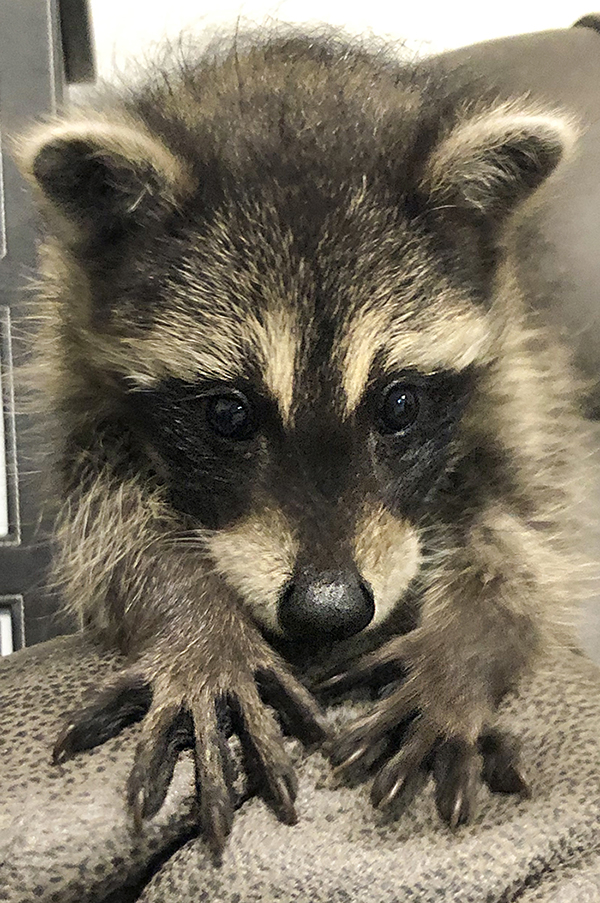 Despite the bright sun, I got some shots of the two black bear cubs. There might be inspiration for a painting or two in the few photos I kept, but I will let them simmer and review them in a few months. My mood and circumstances can colour my perception, so shots that don’t inspire me in August might push the right buttons in January.
Despite the bright sun, I got some shots of the two black bear cubs. There might be inspiration for a painting or two in the few photos I kept, but I will let them simmer and review them in a few months. My mood and circumstances can colour my perception, so shots that don’t inspire me in August might push the right buttons in January.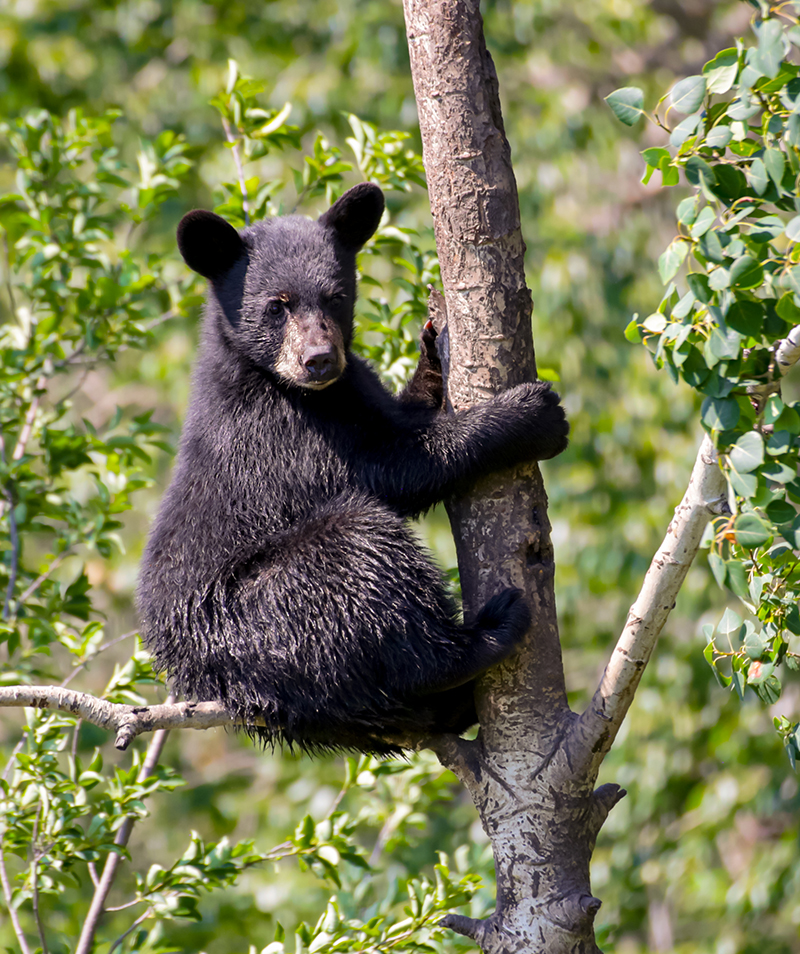 Although I prefer to take my own reference photos whenever possible, I am not interested in becoming a professional photographer. Connecting the dots between aperture, shutter speed and ISO and understanding how they work together, it just seems like math and bores the hell out of me.
Although I prefer to take my own reference photos whenever possible, I am not interested in becoming a professional photographer. Connecting the dots between aperture, shutter speed and ISO and understanding how they work together, it just seems like math and bores the hell out of me.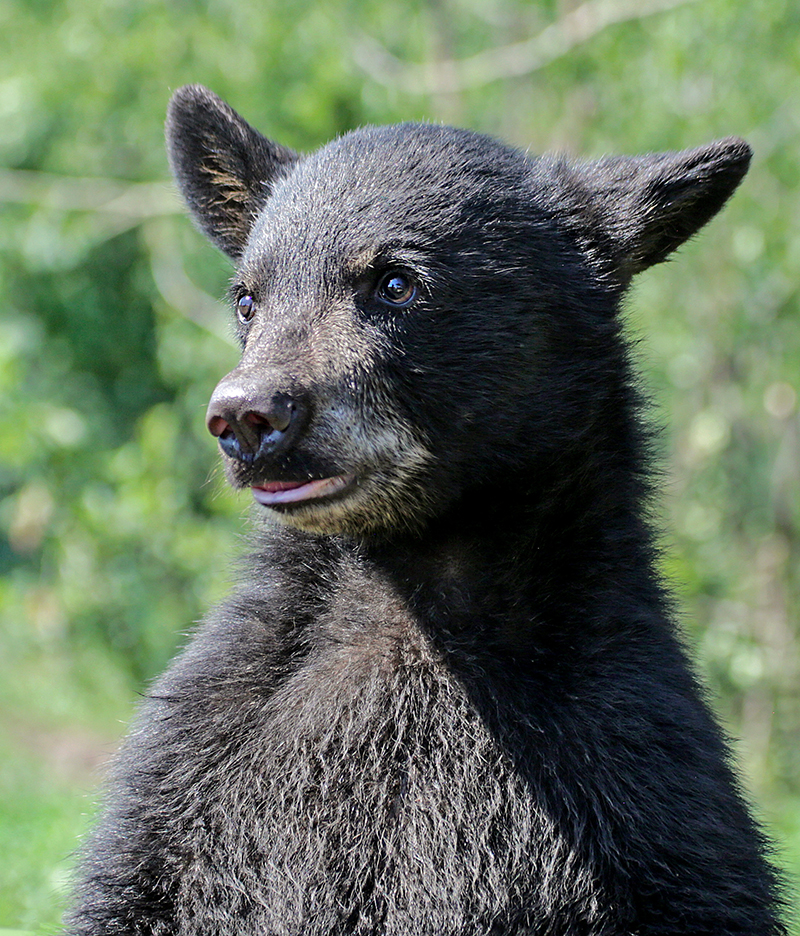 I know that hook because I have it for drawing and painting. I can spend hours detailing little hairs or working to get the texture of a bear’s nose just right. I am confident that would be incredibly dull for most people.
I know that hook because I have it for drawing and painting. I can spend hours detailing little hairs or working to get the texture of a bear’s nose just right. I am confident that would be incredibly dull for most people.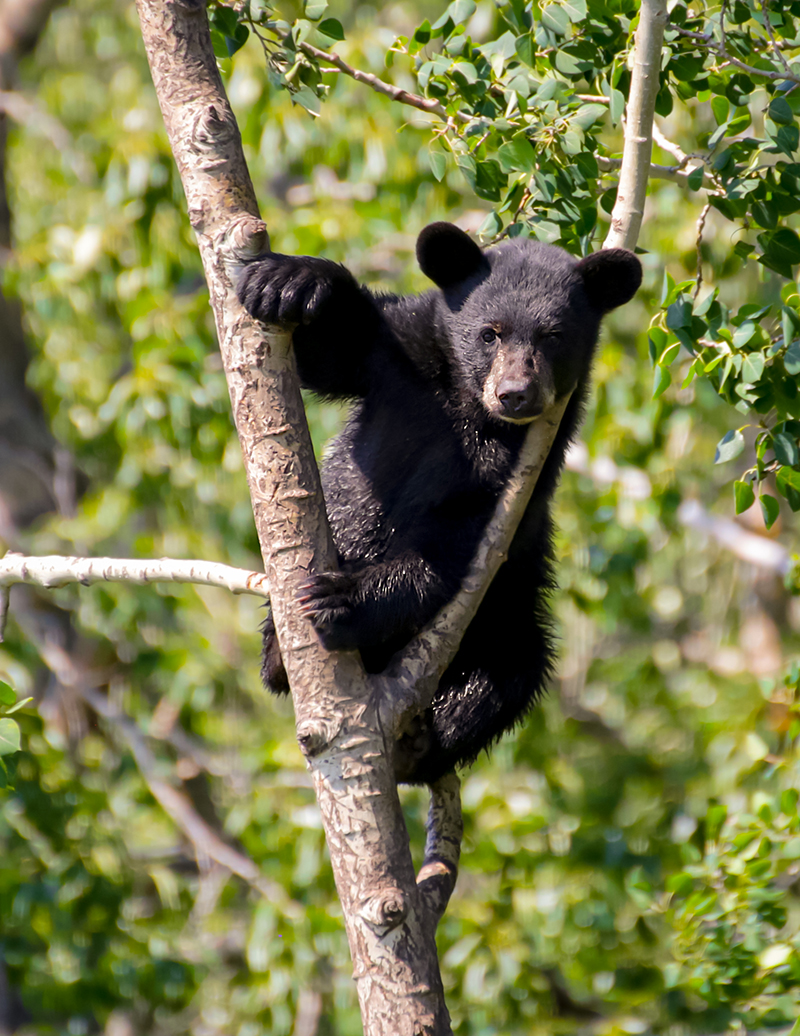 So, while I revel in learning a photography trick or technique that helps me take better reference, like
So, while I revel in learning a photography trick or technique that helps me take better reference, like 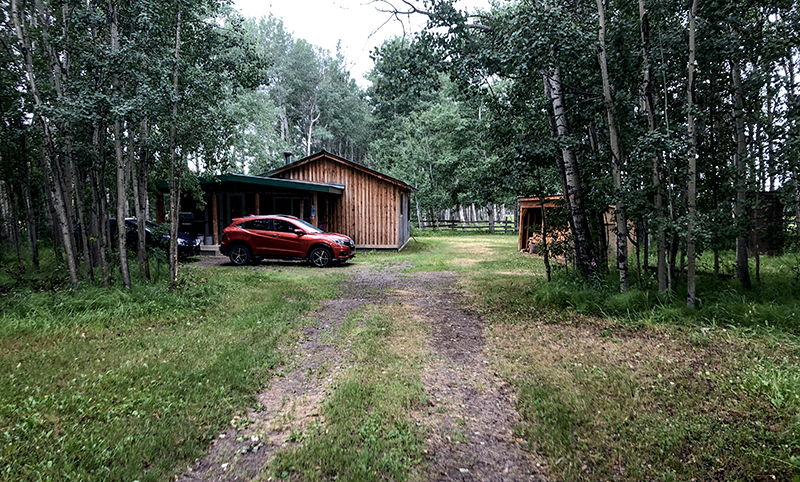 At the end of July, on the day I sent
At the end of July, on the day I sent 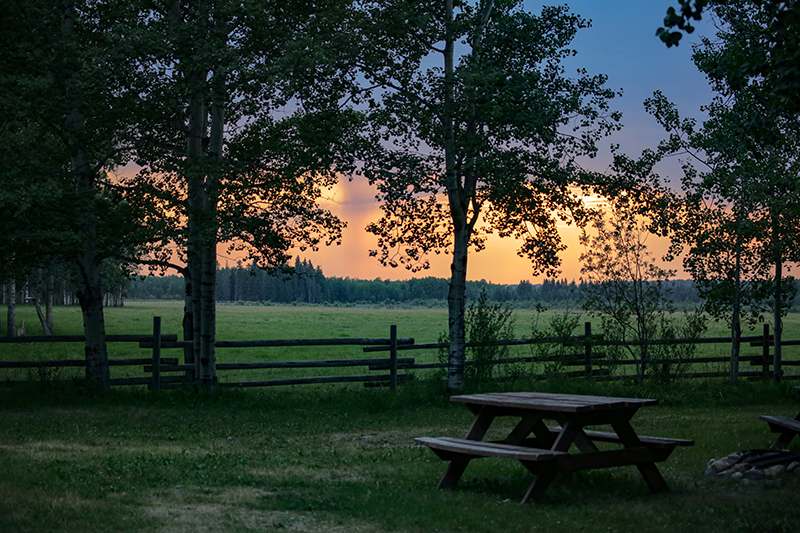 Though most of Alberta had been dealing with heavy wildfire smoke that week, it completely cleared up by the time I got to the cabin and stayed that way the whole four days we were there. The temperature even dropped to a comfortable level and we got some welcome rain. In fact, on the first night, it cooled off so much that we wondered if we might need a fire in the wood stove. Given the oppressive heat we’d just escaped, we had no appetite for that. But wearing long pants and a hoodie seemed strange that evening, given how uncomfortable the past month had been.
Though most of Alberta had been dealing with heavy wildfire smoke that week, it completely cleared up by the time I got to the cabin and stayed that way the whole four days we were there. The temperature even dropped to a comfortable level and we got some welcome rain. In fact, on the first night, it cooled off so much that we wondered if we might need a fire in the wood stove. Given the oppressive heat we’d just escaped, we had no appetite for that. But wearing long pants and a hoodie seemed strange that evening, given how uncomfortable the past month had been.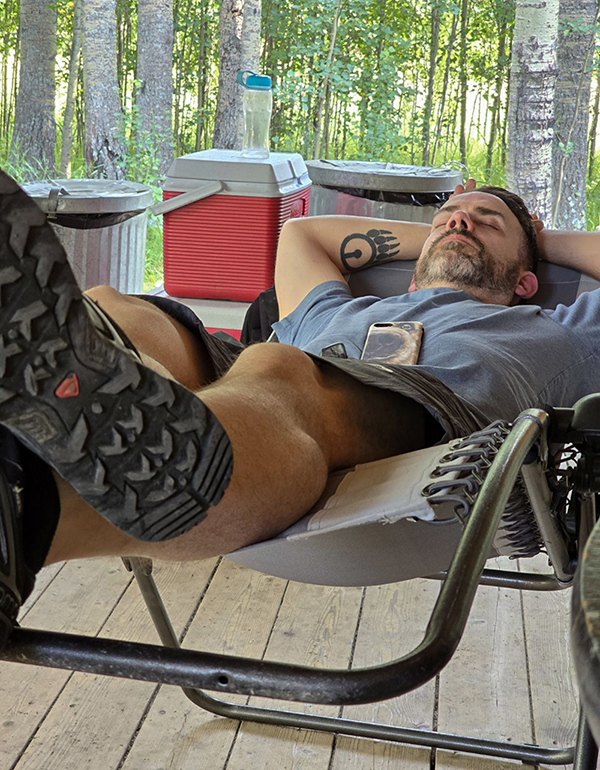 Even though I couldn’t turn off my busy brain, it was good to get away. We did what we always do: sat around talking, napped on the decks in the afternoon, walked around the large property, and played guitar, cards and Scrabble. Yes, we’re boring old men.
Even though I couldn’t turn off my busy brain, it was good to get away. We did what we always do: sat around talking, napped on the decks in the afternoon, walked around the large property, and played guitar, cards and Scrabble. Yes, we’re boring old men.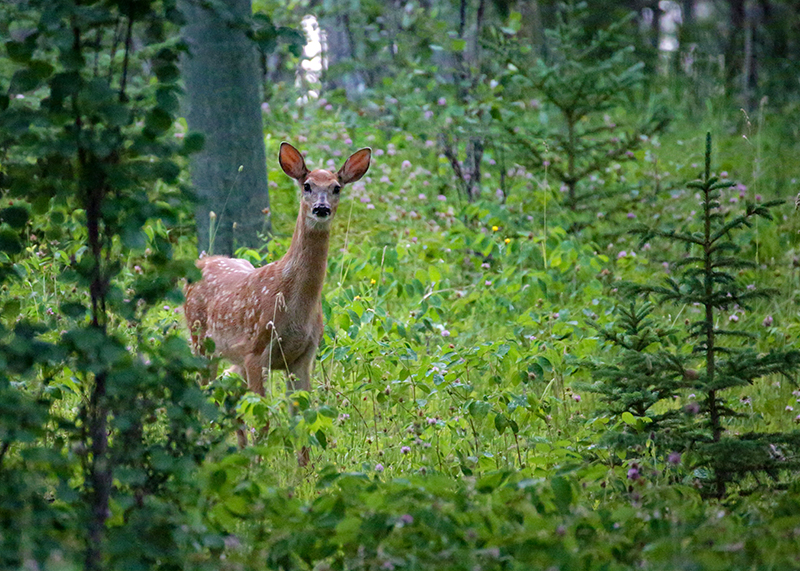 It was a very pretty and delightfully cool morning, and I knew there would be plenty of time to nap on the deck later in the day, so my mood improved. I wandered up the road, spooked a few deer and watched them take off across the neighbour’s newly cut and bailed hayfield. I kept my eyes peeled for other wildlife, hoping for an owl or coyote.
It was a very pretty and delightfully cool morning, and I knew there would be plenty of time to nap on the deck later in the day, so my mood improved. I wandered up the road, spooked a few deer and watched them take off across the neighbour’s newly cut and bailed hayfield. I kept my eyes peeled for other wildlife, hoping for an owl or coyote.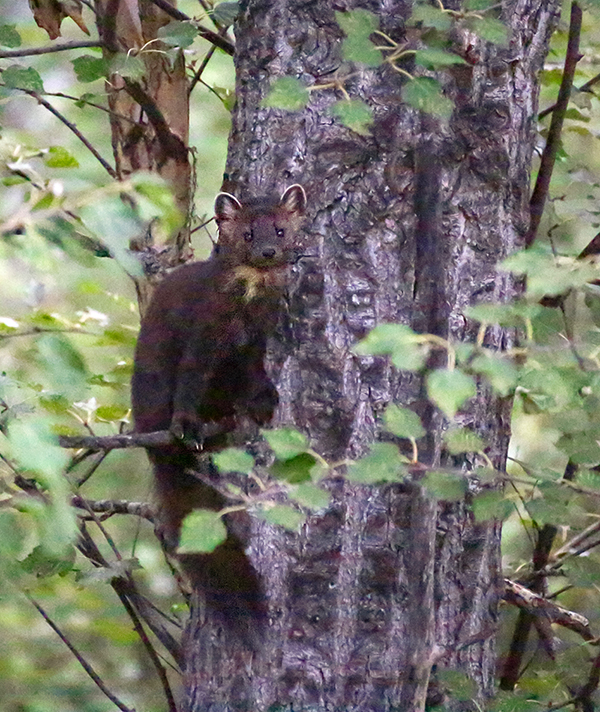 The base of the tree she ran up to escape was twenty feet below me down the steep bank, so her ‘safe height’ now put her at eye level with me as I stood on the road. And she was NOT happy about it.
The base of the tree she ran up to escape was twenty feet below me down the steep bank, so her ‘safe height’ now put her at eye level with me as I stood on the road. And she was NOT happy about it.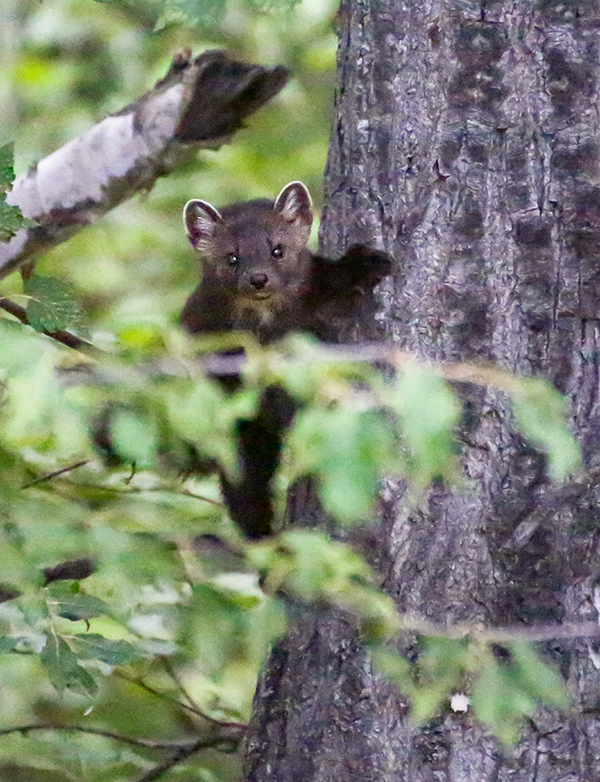 Though I had done what I could to boost my exposure compensation to account for the dark area in which I was shooting, I needed to keep the shutter speed high to try to capture this quick little marten. In the end, none of the pictures I got were very good, but I enjoyed the moment. I don’t know if I have ever seen a pine marten in the wild, but I was pleased with the early morning treat.
Though I had done what I could to boost my exposure compensation to account for the dark area in which I was shooting, I needed to keep the shutter speed high to try to capture this quick little marten. In the end, none of the pictures I got were very good, but I enjoyed the moment. I don’t know if I have ever seen a pine marten in the wild, but I was pleased with the early morning treat.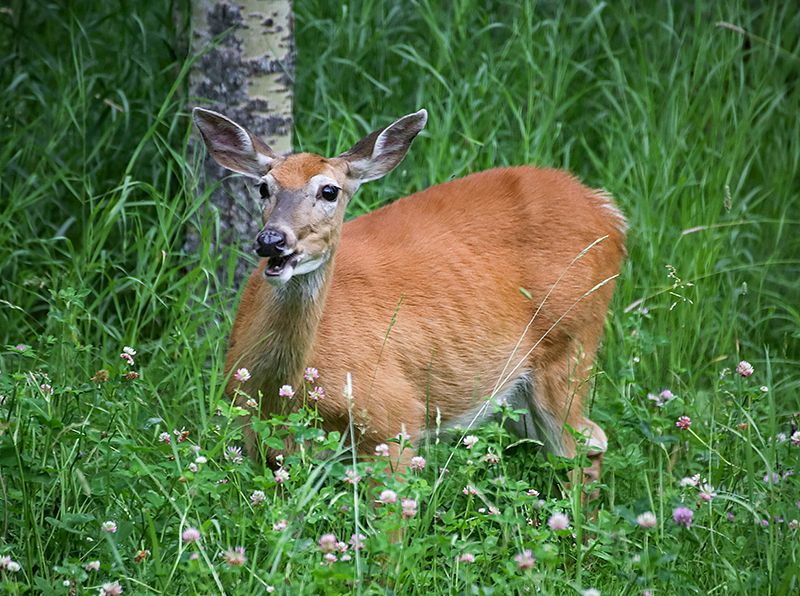 .
.
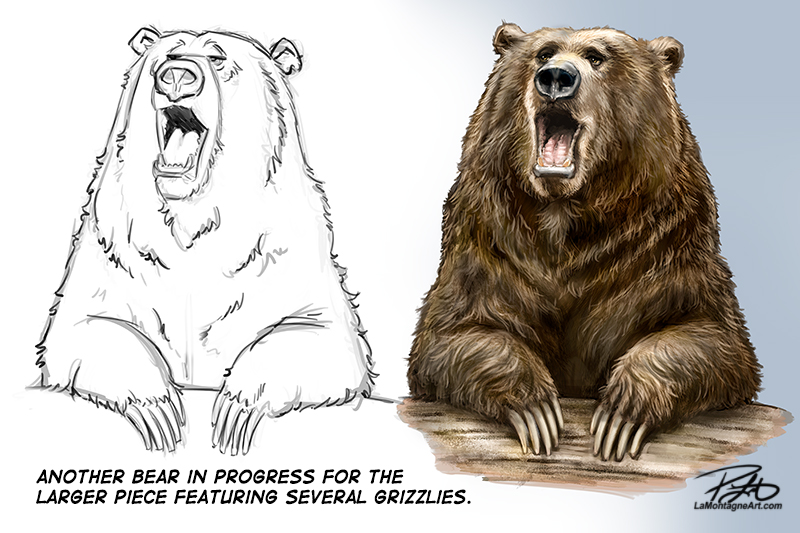 The paintings I was already working on need to be done by the end of next month so I can order puzzles and products for the markets. Then there are the sketches, paintings and writing for the book, six editorial
The paintings I was already working on need to be done by the end of next month so I can order puzzles and products for the markets. Then there are the sketches, paintings and writing for the book, six editorial 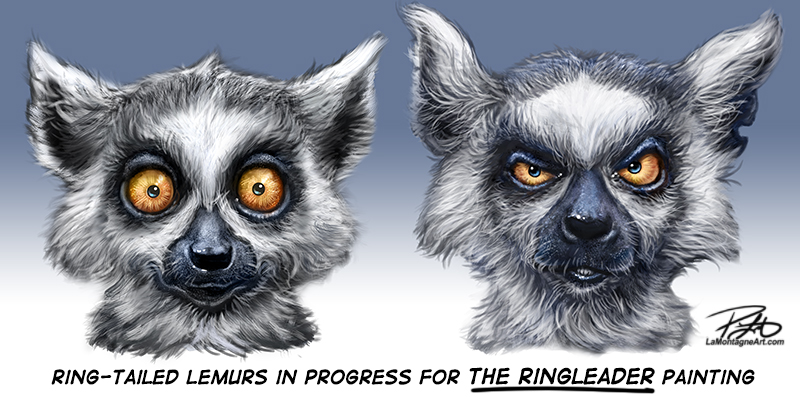 Sure, I’ll bitch about being too busy sometimes, but I chose this. Though the landscape will change, as will the work, and it’s unlikely ever to get easier, I plan to create art as long as possible. I don’t know if I could do anything else, now.
Sure, I’ll bitch about being too busy sometimes, but I chose this. Though the landscape will change, as will the work, and it’s unlikely ever to get easier, I plan to create art as long as possible. I don’t know if I could do anything else, now.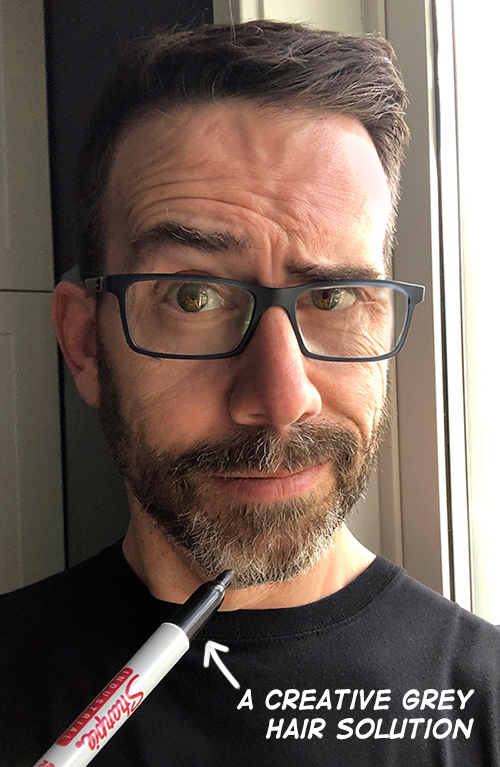 I’m grateful for so many of you who follow my work, comment on my posts or write emails, sending me wildlife pictures and thoughts about something I’ve shared or the artwork in general. With so much content available to us, that anyone volunteers to receive my
I’m grateful for so many of you who follow my work, comment on my posts or write emails, sending me wildlife pictures and thoughts about something I’ve shared or the artwork in general. With so much content available to us, that anyone volunteers to receive my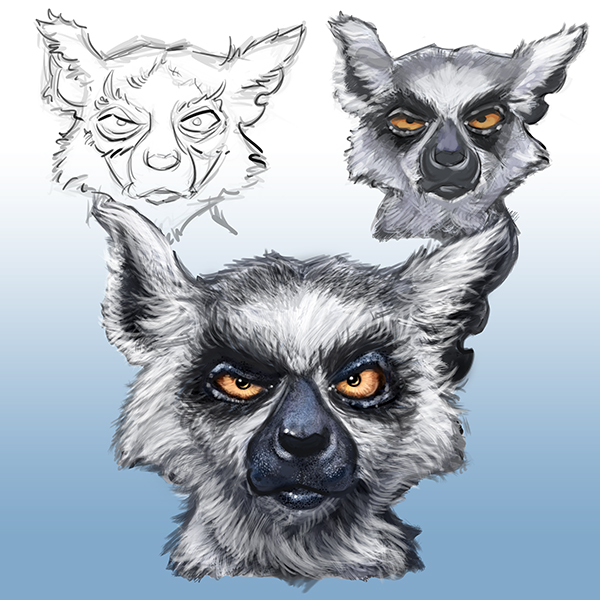
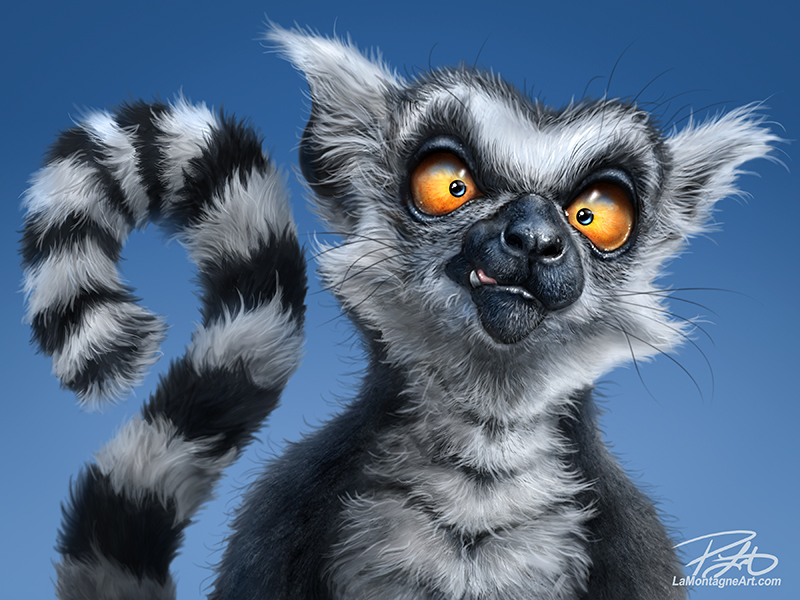
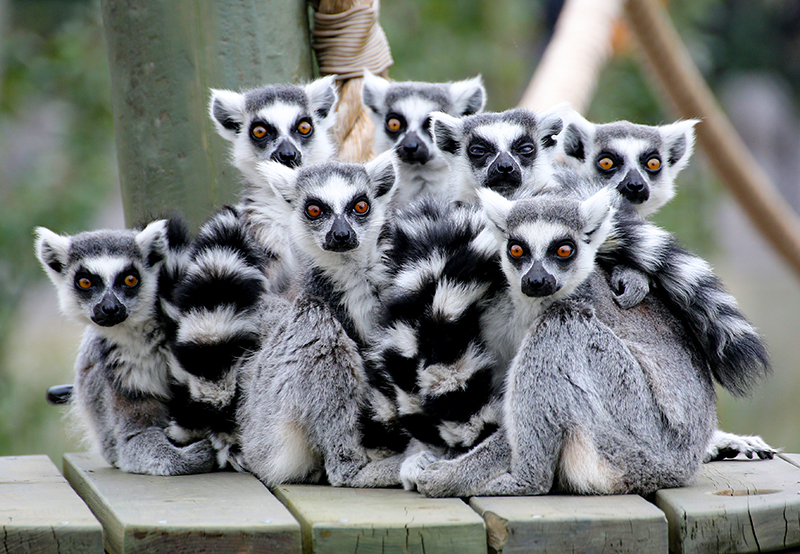 This photo always makes me chuckle. That evil-looking stare straight down my lens, the squinting focused eyes, the chunk missing from her ear. She reminds me of a gangster saying, “Come closer. See what happens.”
This photo always makes me chuckle. That evil-looking stare straight down my lens, the squinting focused eyes, the chunk missing from her ear. She reminds me of a gangster saying, “Come closer. See what happens.”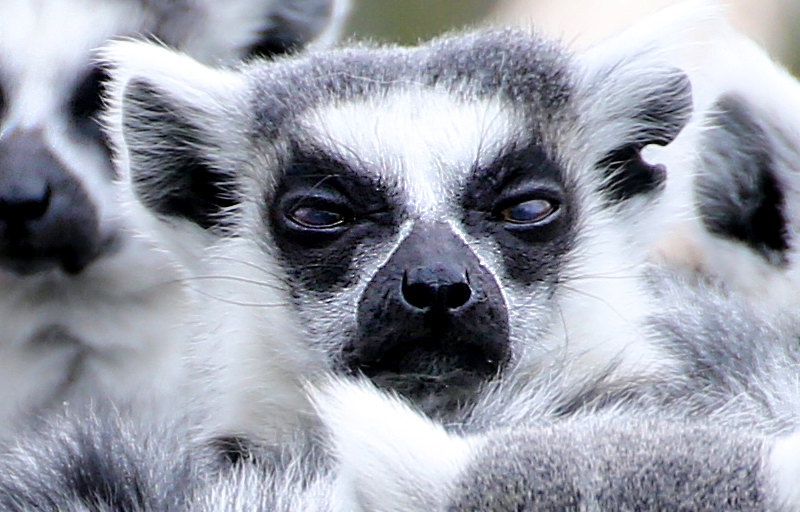
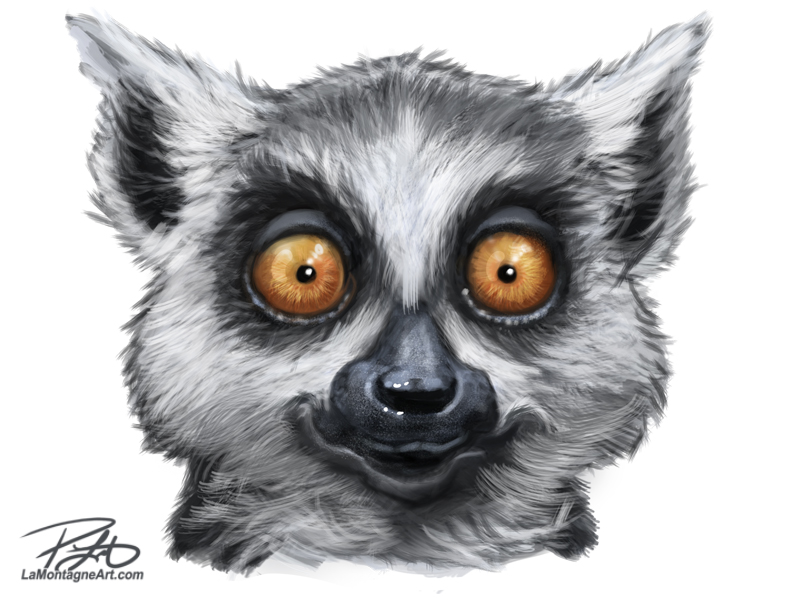 I’m happy with how it’s turned out so far, and I’m also hoping to offer the finished piece as a puzzle later this year.
I’m happy with how it’s turned out so far, and I’m also hoping to offer the finished piece as a puzzle later this year.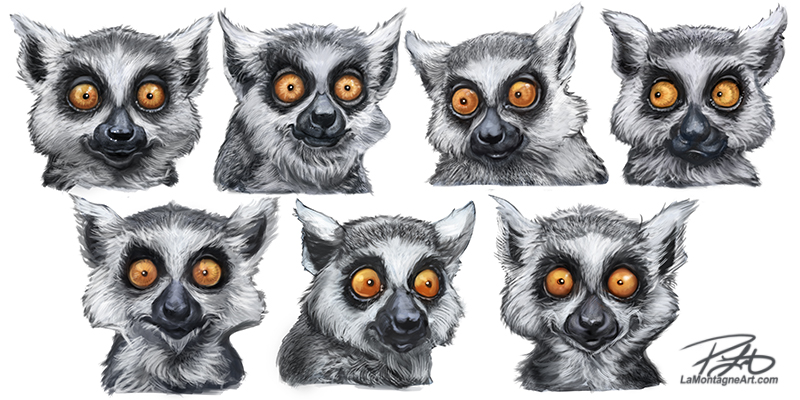 So, when I’m working on several paintings at once and more involved pieces featuring multiple animals or more detailed backgrounds, paintings that take much longer than a whimsical head and shoulders portrait can be uncomfortable. It feels like I’m not getting enough done.
So, when I’m working on several paintings at once and more involved pieces featuring multiple animals or more detailed backgrounds, paintings that take much longer than a whimsical head and shoulders portrait can be uncomfortable. It feels like I’m not getting enough done.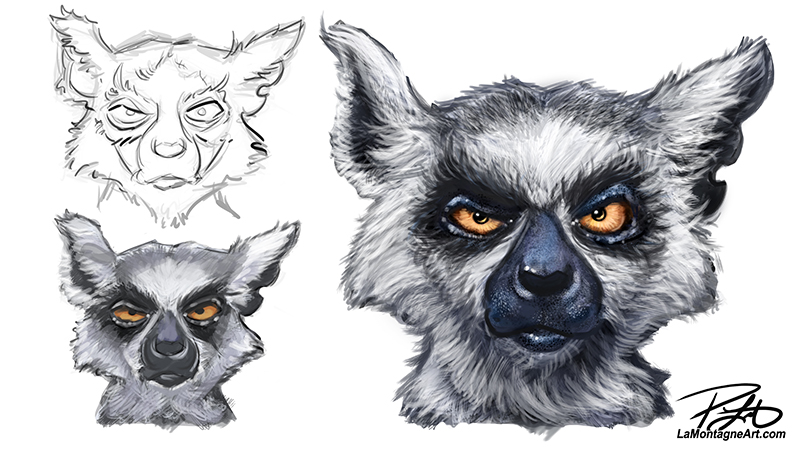 The finished piece will be a lot more detailed than the images in progress you see here. But the vision for what I’m trying to achieve is clear in my mind, and I’m having fun discovering each of these faces.
The finished piece will be a lot more detailed than the images in progress you see here. But the vision for what I’m trying to achieve is clear in my mind, and I’m having fun discovering each of these faces.
 We stayed up waiting for the northern lights Friday, but with none arriving by 11, we retreated to our separate spaces. I’m indeed one of the old guys now.
We stayed up waiting for the northern lights Friday, but with none arriving by 11, we retreated to our separate spaces. I’m indeed one of the old guys now.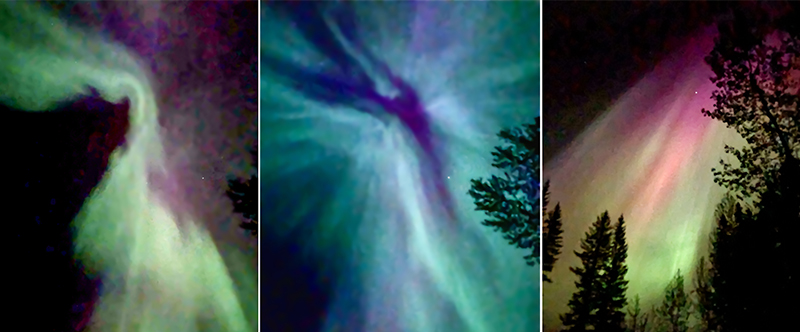 The next morning, I admitted that just before I knocked on a dark, quiet trailer, I wondered if I was painting a target on my chest. Nobody likes to be woken from a dead sleep. Thankfully, all agreed it was worth it. After all, that’s what Saturday afternoon lawn chair naps are for.
The next morning, I admitted that just before I knocked on a dark, quiet trailer, I wondered if I was painting a target on my chest. Nobody likes to be woken from a dead sleep. Thankfully, all agreed it was worth it. After all, that’s what Saturday afternoon lawn chair naps are for.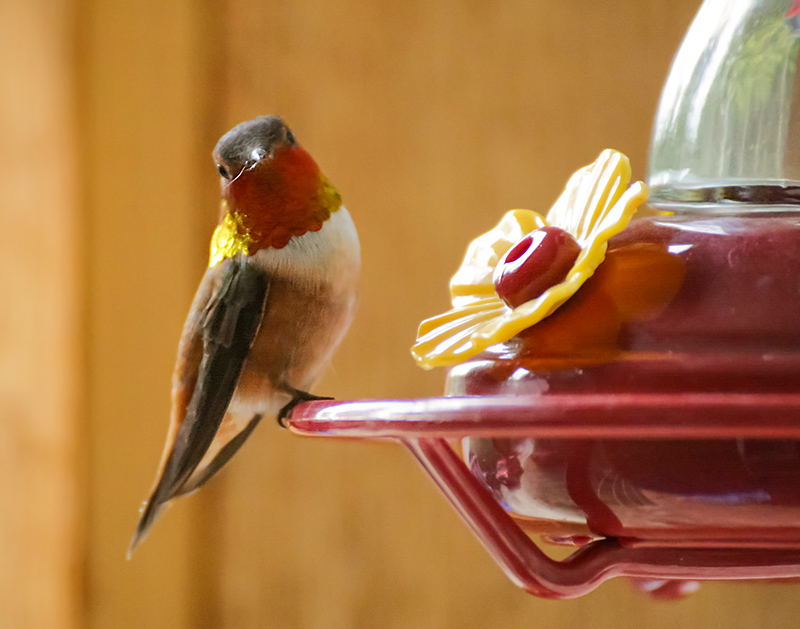 On Saturday, several hummingbirds made rounds at three or four feeders Babe and Sue have around their home. Having never before captured decent shots of these tiny speedsters, I must have learned a few things over the years as I came home with several potential reference photos, more than you see here.
On Saturday, several hummingbirds made rounds at three or four feeders Babe and Sue have around their home. Having never before captured decent shots of these tiny speedsters, I must have learned a few things over the years as I came home with several potential reference photos, more than you see here.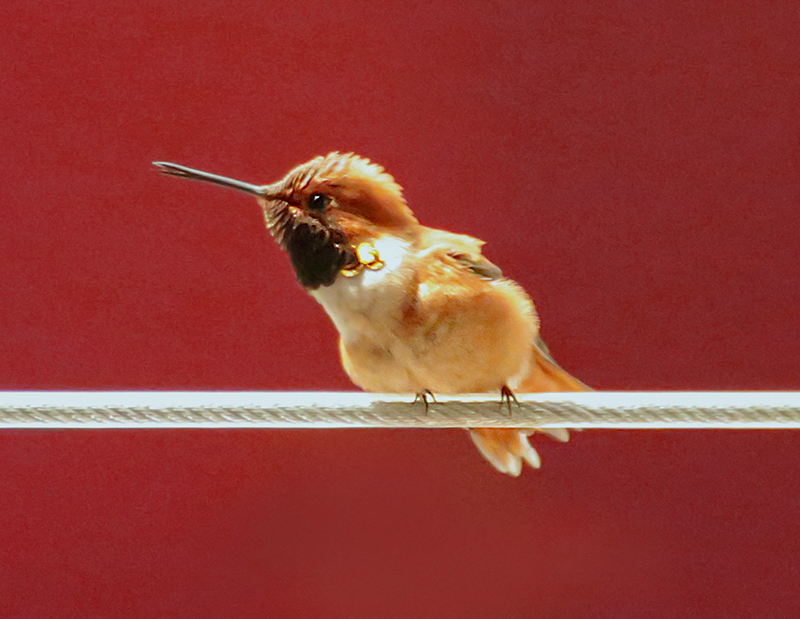 While these photos are edited, of course, that convenient red background is Babe’s little barn garage for his trailer, as a couple of the hummingbirds landed and sat on the safety wire surrounding the deck of the house.
While these photos are edited, of course, that convenient red background is Babe’s little barn garage for his trailer, as a couple of the hummingbirds landed and sat on the safety wire surrounding the deck of the house.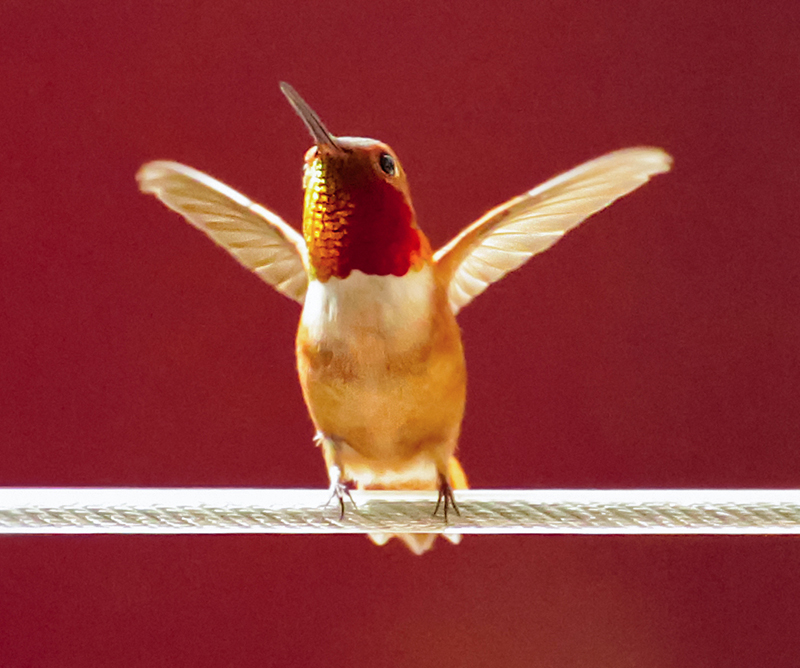 My first instinct is to paint several of these poses, a line of little hummingbirds on the same wire, and devise my own vibrant colour scheme for each bird. I’m sure that seems like sacrilege to any hardcore birders, but my art doesn’t represent reality. I guess I’ll see what happens when I get into it, whenever that might be.
My first instinct is to paint several of these poses, a line of little hummingbirds on the same wire, and devise my own vibrant colour scheme for each bird. I’m sure that seems like sacrilege to any hardcore birders, but my art doesn’t represent reality. I guess I’ll see what happens when I get into it, whenever that might be. Regardless of how or when I paint from these pics, I enjoyed stalking the quick little critters. The best part about taking wildlife photos strictly for reference is that it doesn’t matter if the backgrounds or lighting aren’t great. Where a wildlife photographer might not see an image worthy of sharing or printing, all I care about is the detail and whether it inspires a possible painting or two.
Regardless of how or when I paint from these pics, I enjoyed stalking the quick little critters. The best part about taking wildlife photos strictly for reference is that it doesn’t matter if the backgrounds or lighting aren’t great. Where a wildlife photographer might not see an image worthy of sharing or printing, all I care about is the detail and whether it inspires a possible painting or two.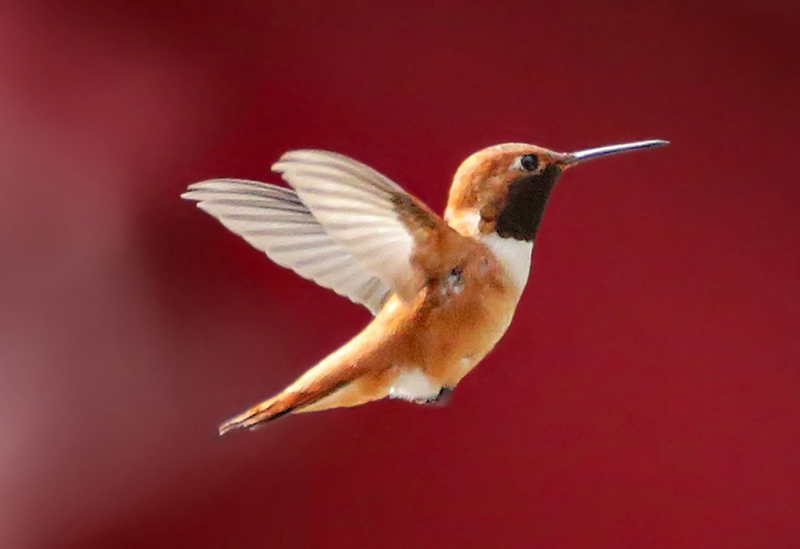 And that’s my cue to head back to the drawing board. Next time, I’ll have some new artwork to share, or at least some works in progress.
And that’s my cue to head back to the drawing board. Next time, I’ll have some new artwork to share, or at least some works in progress.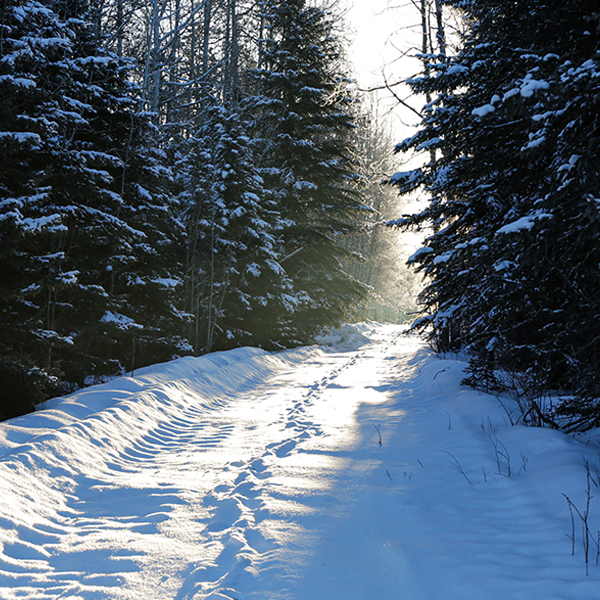
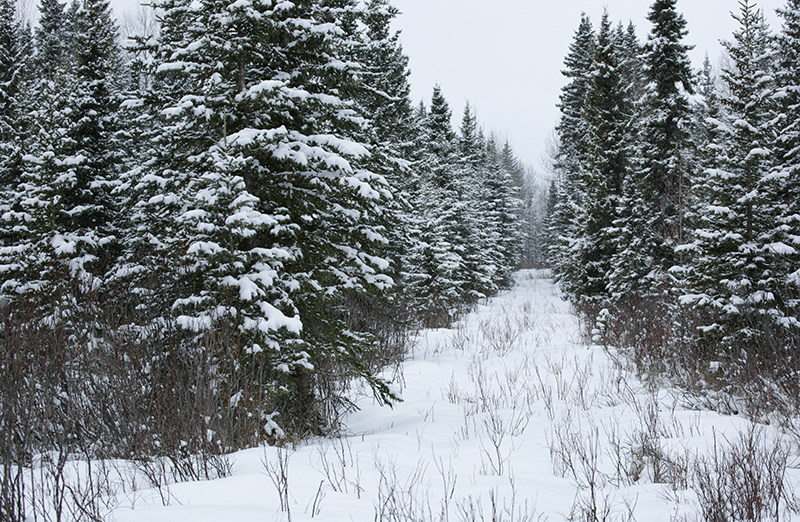 Most years, I’d rather let my birthday go unnoticed, and thankfully, I married someone who feels the same way about hers. If someone mentioned having a birthday ‘party’ for me, my first thought would be, “What the hell did I ever do to you?”
Most years, I’d rather let my birthday go unnoticed, and thankfully, I married someone who feels the same way about hers. If someone mentioned having a birthday ‘party’ for me, my first thought would be, “What the hell did I ever do to you?” But on the northern border of that same property, nestled beside secluded wetlands, there is another cabin. It’s one room, one bed, solar power for lights, an outhouse, no water and no noise. It’s at the end of a road, behind a gate on private property.
But on the northern border of that same property, nestled beside secluded wetlands, there is another cabin. It’s one room, one bed, solar power for lights, an outhouse, no water and no noise. It’s at the end of a road, behind a gate on private property.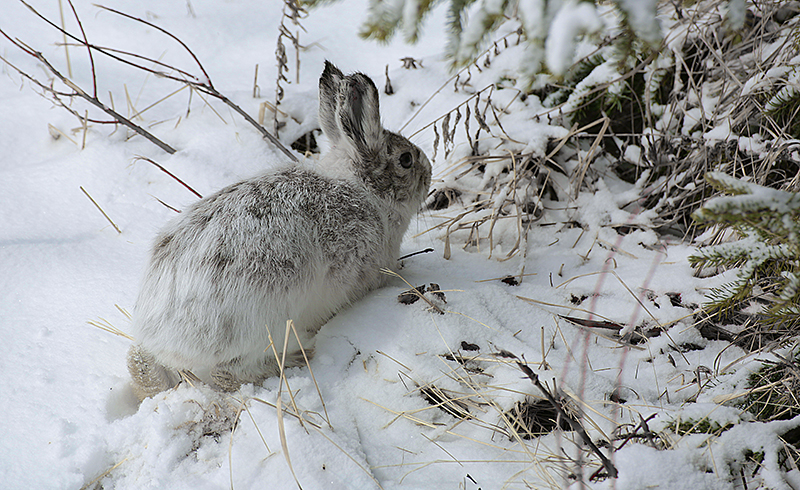 While shovelling snow, I scared a snowshoe hare out from under the deck, and I took that as a good sign. I wanted to see wildlife, even though this critter did not want to see me.
While shovelling snow, I scared a snowshoe hare out from under the deck, and I took that as a good sign. I wanted to see wildlife, even though this critter did not want to see me. The property owners have become friends over the years, and I like to visit them. While on my daily wanders, I walked up to their place a couple of times, a 5-6 km round trip from where I was staying, as I had no interest in taking the shortest route.
The property owners have become friends over the years, and I like to visit them. While on my daily wanders, I walked up to their place a couple of times, a 5-6 km round trip from where I was staying, as I had no interest in taking the shortest route.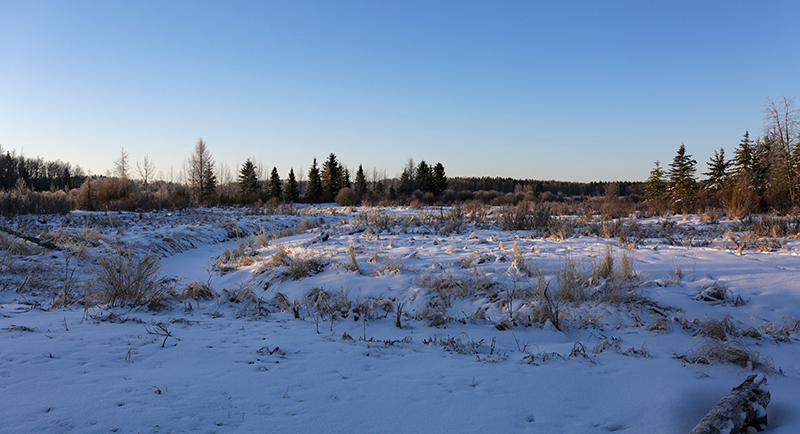 Free to roam more than 300 acres of pasture, wetlands, and forest, I walked close to 20km over 72 hours in snow and sunshine. It was peaceful and very pretty.
Free to roam more than 300 acres of pasture, wetlands, and forest, I walked close to 20km over 72 hours in snow and sunshine. It was peaceful and very pretty.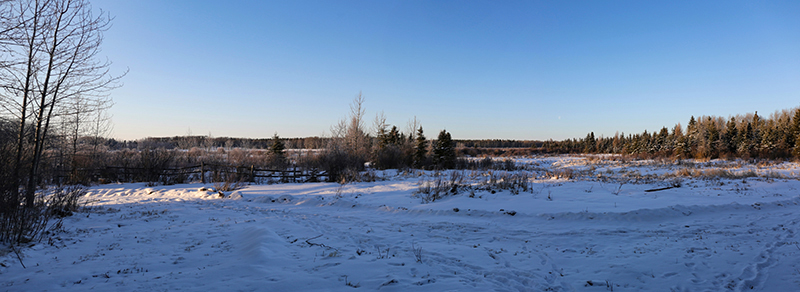 In the new fallen snow, fresh moose, coyote, deer and rabbit tracks were all over the place, many of them just hours old. I heard the coyotes at night and in the morning, and that was nice. It’s one of my favourite sounds. I listened to an owl calling two nights in a row. But all I saw were little birds flying here and there, a few ravens, a couple of geese, and that scared little bunny when I first arrived.
In the new fallen snow, fresh moose, coyote, deer and rabbit tracks were all over the place, many of them just hours old. I heard the coyotes at night and in the morning, and that was nice. It’s one of my favourite sounds. I listened to an owl calling two nights in a row. But all I saw were little birds flying here and there, a few ravens, a couple of geese, and that scared little bunny when I first arrived.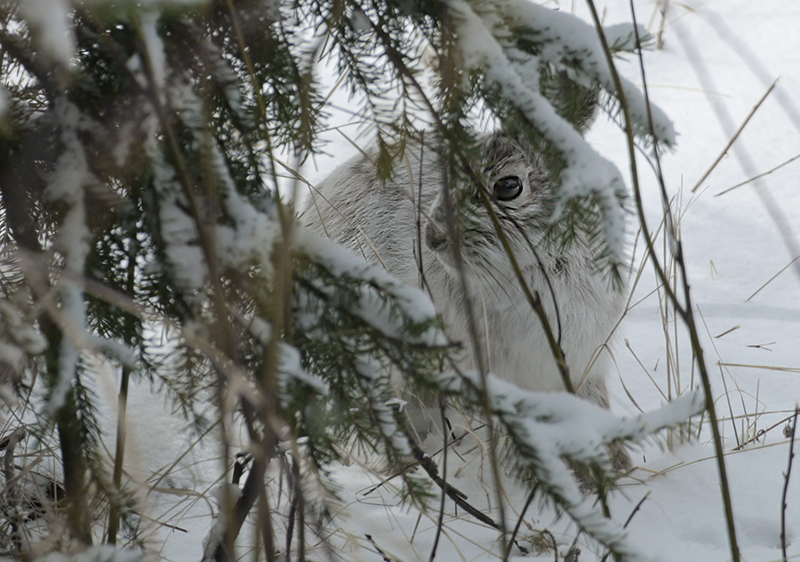 I know professional photographers who spend great amounts of time, energy and money to get to remote places, park themselves in a blind, right next to a game trail for hours and days on end, and often come home with little or nothing to show for it.
I know professional photographers who spend great amounts of time, energy and money to get to remote places, park themselves in a blind, right next to a game trail for hours and days on end, and often come home with little or nothing to show for it.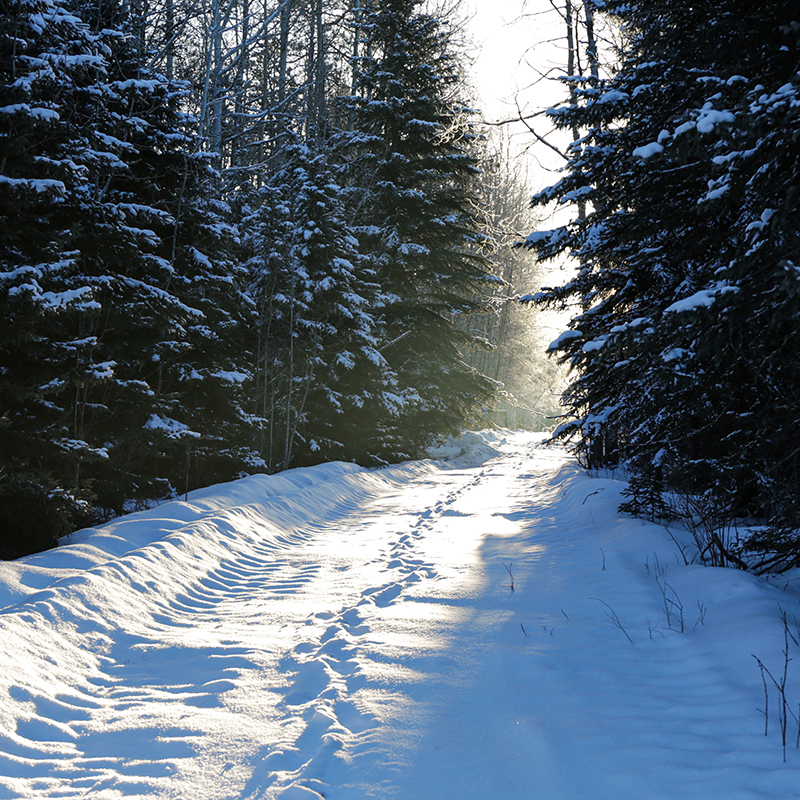 I spent my birthday by myself, without anyone telling me how I should be celebrating it. I got up early, as I prefer, without walking on eggshells for fear of waking anybody up, which is often the case on cabin visits with friends. I played guitar and sang, fumbled with chord changes, learning songs I didn’t know, without intruding on anyone else’s peace and quiet.
I spent my birthday by myself, without anyone telling me how I should be celebrating it. I got up early, as I prefer, without walking on eggshells for fear of waking anybody up, which is often the case on cabin visits with friends. I played guitar and sang, fumbled with chord changes, learning songs I didn’t know, without intruding on anyone else’s peace and quiet.
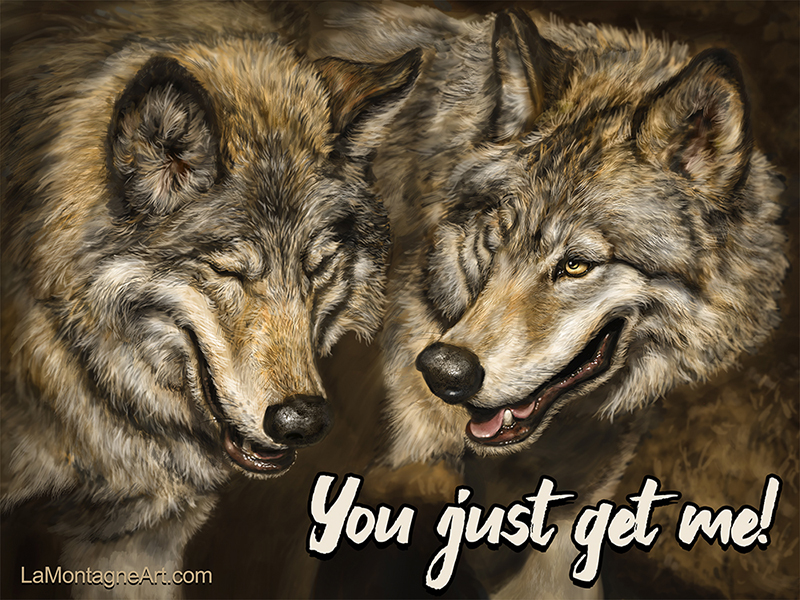 If you’re like me, bombarded daily with negative news and polarized opinions, this noisy world can become overwhelming. It bothers me, and I often wonder, “Why are people so mean to each other?”
If you’re like me, bombarded daily with negative news and polarized opinions, this noisy world can become overwhelming. It bothers me, and I often wonder, “Why are people so mean to each other?”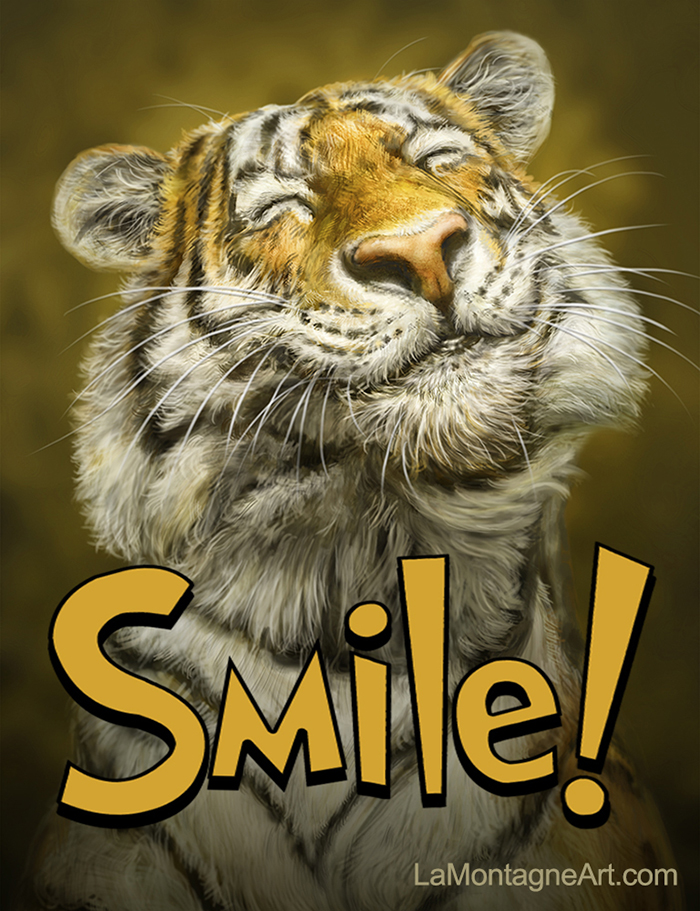 It’s a moment of connection between my funny-looking animals and people I’ve never met. I love watching it happen, and it is a reminder that something I created made somebody else’s day a little better, if only for a moment. In a world that often seems nasty, with people intent on highlighting our worst qualities, I create art that makes people smile. I often forget that, but when I do remember, I’m grateful for this ability.
It’s a moment of connection between my funny-looking animals and people I’ve never met. I love watching it happen, and it is a reminder that something I created made somebody else’s day a little better, if only for a moment. In a world that often seems nasty, with people intent on highlighting our worst qualities, I create art that makes people smile. I often forget that, but when I do remember, I’m grateful for this ability.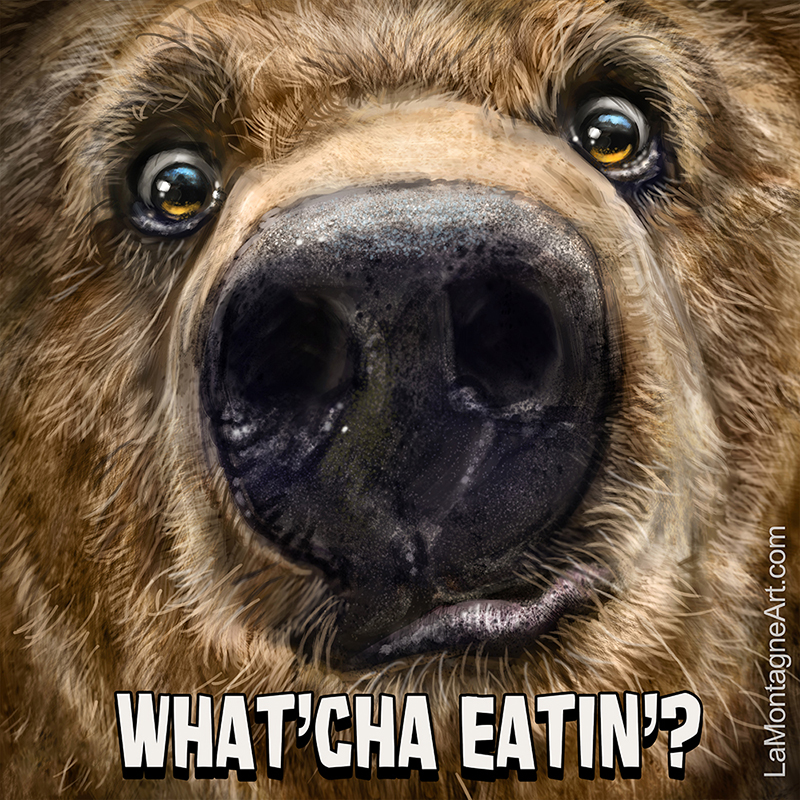 If you know me well, all this might sound hypocritical. I struggle with seeing the good in the world, which often puts me in a dark mood. But just like a smoker knows the habit is unhealthy, it’s worth the effort to try to cut back and eventually quit.
If you know me well, all this might sound hypocritical. I struggle with seeing the good in the world, which often puts me in a dark mood. But just like a smoker knows the habit is unhealthy, it’s worth the effort to try to cut back and eventually quit.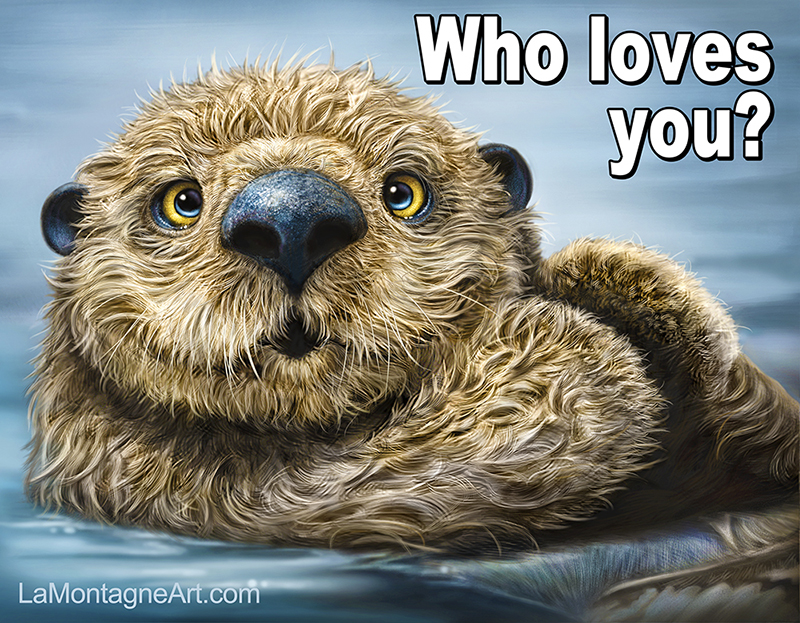 So, to spread some positive feelings around, I created these Wilder Wishes images you see here, from some of
So, to spread some positive feelings around, I created these Wilder Wishes images you see here, from some of 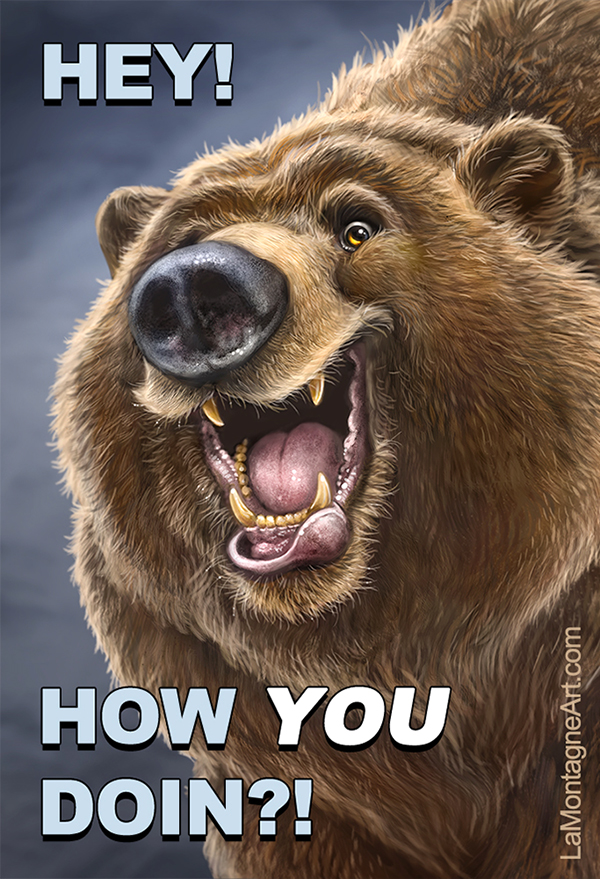 If one of these happy faces makes the day a little brighter, for you or somebody else, then that makes mine better, too. Sometimes, you’ve got to give a smile to get one back.
If one of these happy faces makes the day a little brighter, for you or somebody else, then that makes mine better, too. Sometimes, you’ve got to give a smile to get one back.
 My buddy Darrel and I spent five days last week at the cabin we rent in the foothills of central Alberta. Even though our first visit there was in January of 2018, we don’t often go during the winter months.
My buddy Darrel and I spent five days last week at the cabin we rent in the foothills of central Alberta. Even though our first visit there was in January of 2018, we don’t often go during the winter months. Back to work, I’m already preparing for the
Back to work, I’m already preparing for the 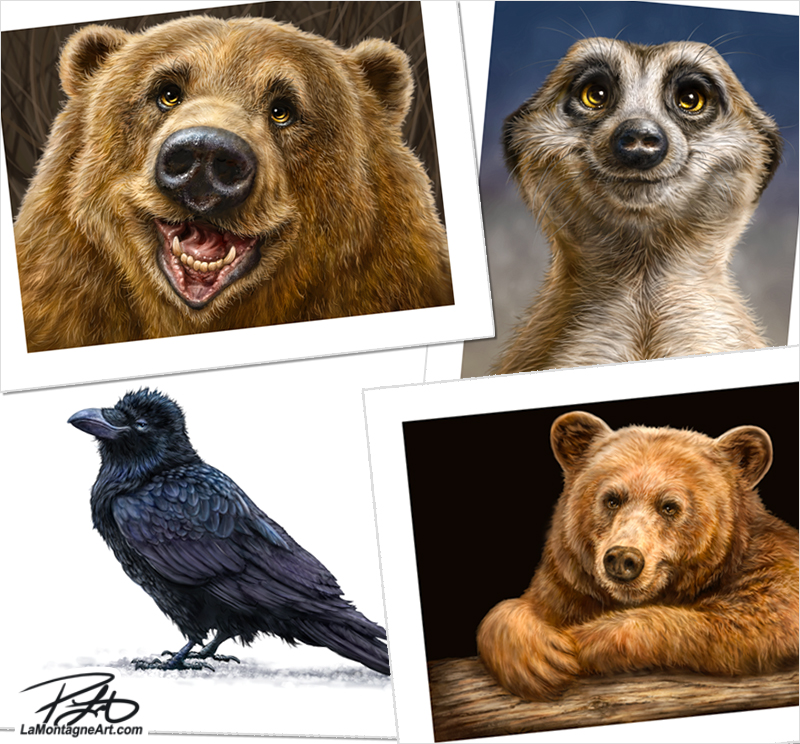


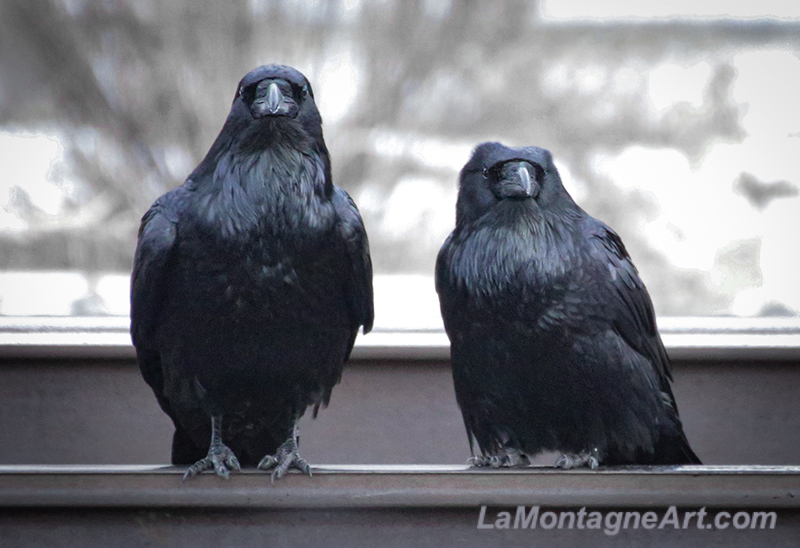 You can attribute it to seasonal affective disorder, lack of light, or the extreme cold weather that settled in this week, but January is not my favourite month. I am at my most miserable and misanthropic this time of year, coupled with a short fuse. My jaw has been bugging me for a couple of weeks, a consequence of unconscious clenching and teeth grinding. I’m not sleeping well and have bad dreams.
You can attribute it to seasonal affective disorder, lack of light, or the extreme cold weather that settled in this week, but January is not my favourite month. I am at my most miserable and misanthropic this time of year, coupled with a short fuse. My jaw has been bugging me for a couple of weeks, a consequence of unconscious clenching and teeth grinding. I’m not sleeping well and have bad dreams.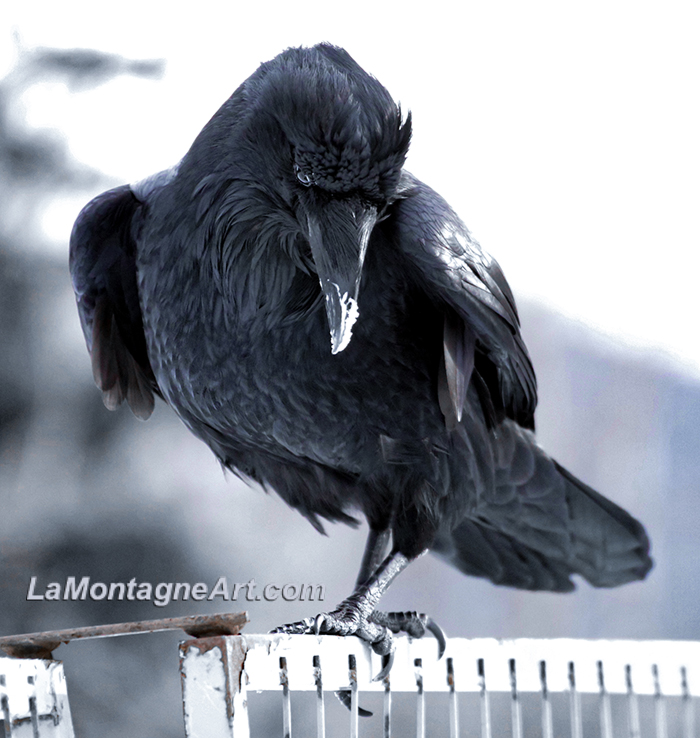 But at the moment, each
But at the moment, each 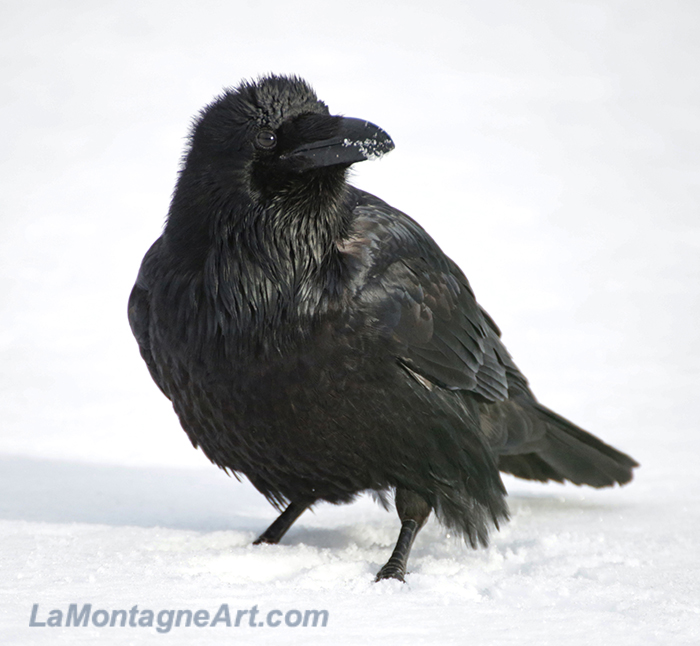 On the way, there’s a long stretch of paved pathway beside the train tracks. It runs behind another grocery store, recycling drop-off, and Canadian Tire and several ravens hang out in the area, scavenging for scraps.
On the way, there’s a long stretch of paved pathway beside the train tracks. It runs behind another grocery store, recycling drop-off, and Canadian Tire and several ravens hang out in the area, scavenging for scraps.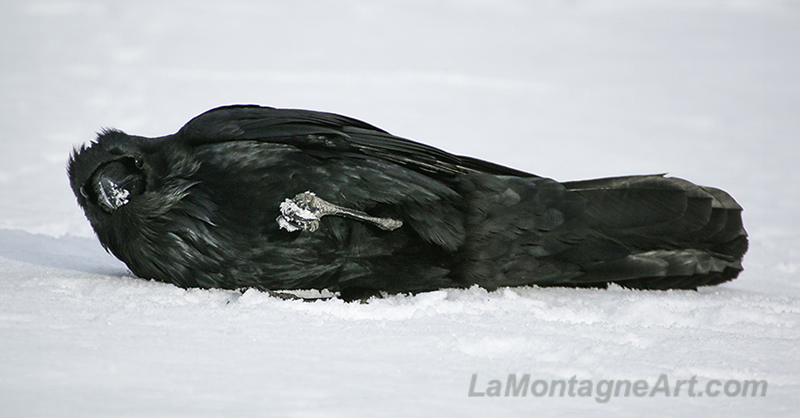 But when a raven flops down on his back and rolls around in the snow, pausing several times to look right into my lens, it’s hard not to imagine it’s doing it for my benefit. I took quite a few shots of this clown before he (or she) finally got back on his feet.
But when a raven flops down on his back and rolls around in the snow, pausing several times to look right into my lens, it’s hard not to imagine it’s doing it for my benefit. I took quite a few shots of this clown before he (or she) finally got back on his feet.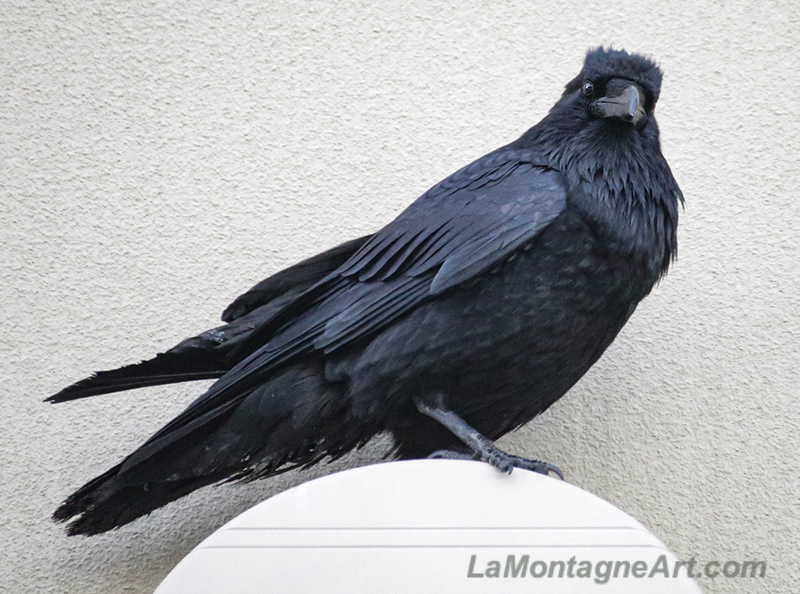 Thanks to a recent photo tip technique on my friend
Thanks to a recent photo tip technique on my friend 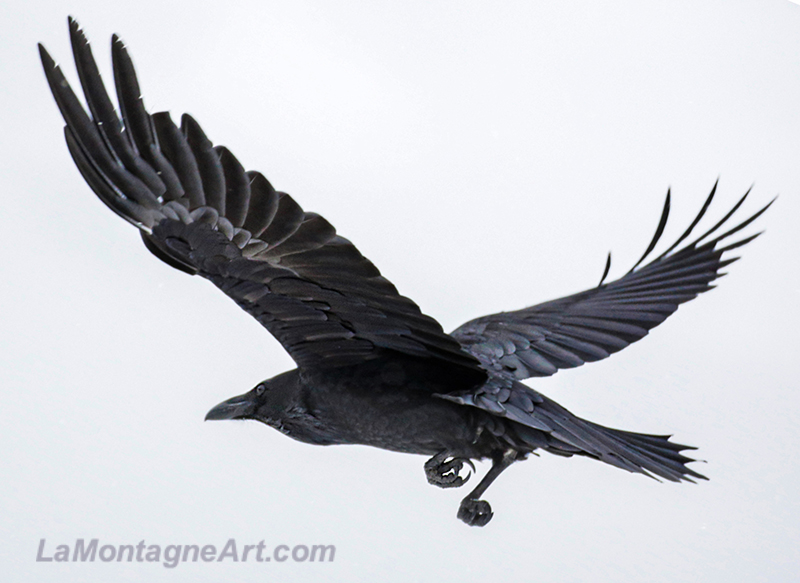 While a professional photographer might deem them unworthy for prints or portfolio pieces, I use the photos strictly for reference, so any flaws don’t matter.
While a professional photographer might deem them unworthy for prints or portfolio pieces, I use the photos strictly for reference, so any flaws don’t matter.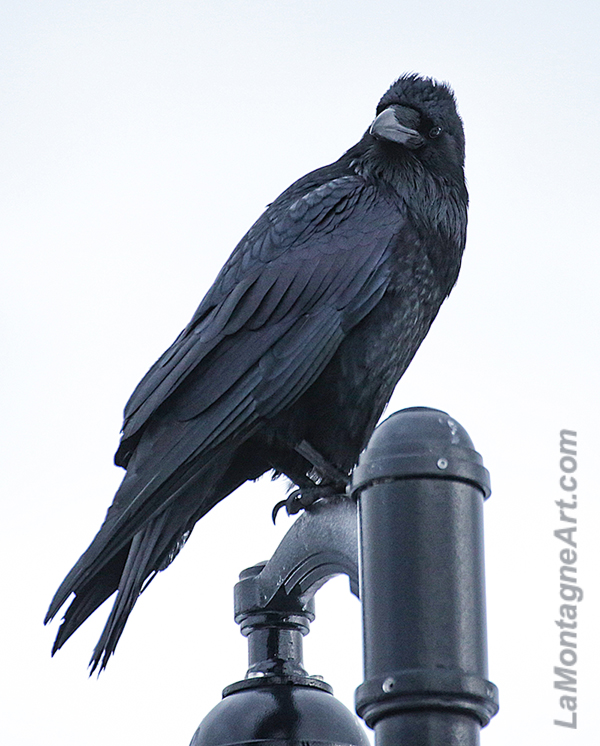 Though I’m struggling to find my creative spark right now, I know it will return as spring gets closer, and my mood will improve with more sunlight and warmer weather. It always does. And should I want to paint more ravens then, I’ll be grateful I forced myself to get out now and that I took my camera with me, even though I didn’t feel like it.
Though I’m struggling to find my creative spark right now, I know it will return as spring gets closer, and my mood will improve with more sunlight and warmer weather. It always does. And should I want to paint more ravens then, I’ll be grateful I forced myself to get out now and that I took my camera with me, even though I didn’t feel like it.
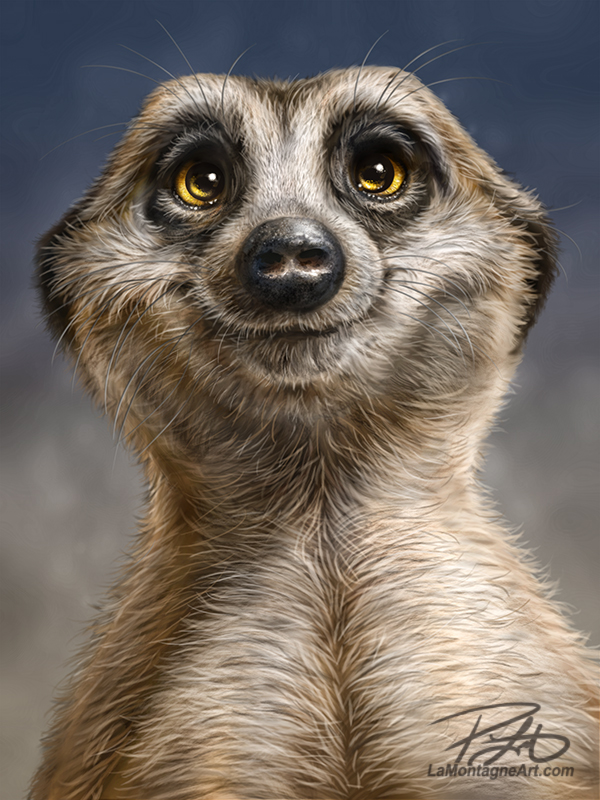 I’ve taken hundreds of meerkat photos at the
I’ve taken hundreds of meerkat photos at the 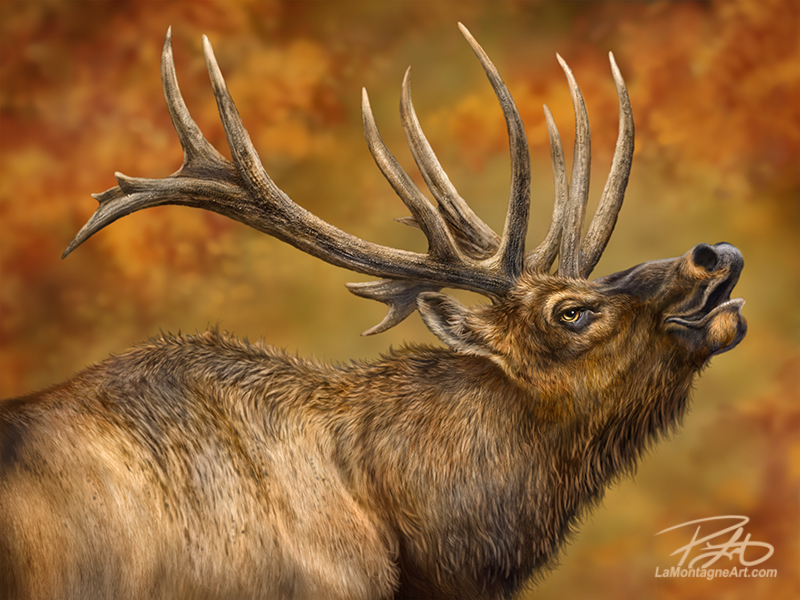
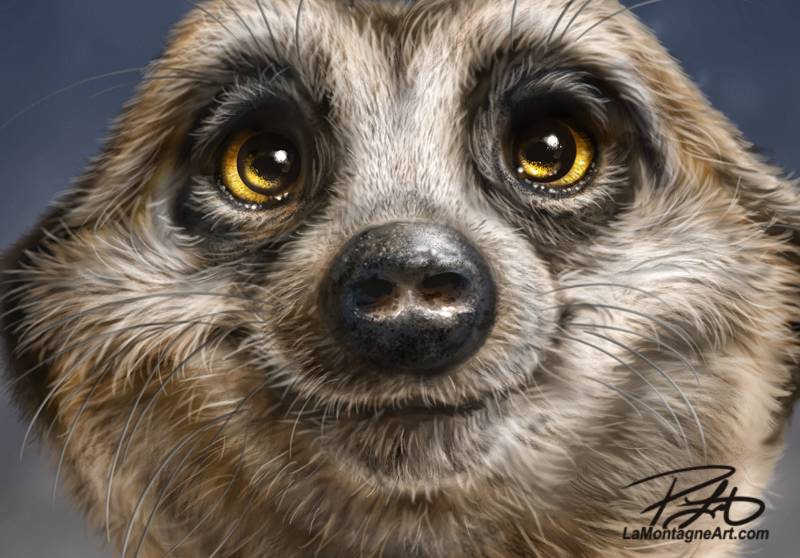 When it came to meerkats, I’ve long had the idea to paint a whole troop of them, so painting a solitary meerkat wasn’t on the radar, or I’d do the occasional sketch painting, but never a finished production piece. But just like the three giraffes I painted for my
When it came to meerkats, I’ve long had the idea to paint a whole troop of them, so painting a solitary meerkat wasn’t on the radar, or I’d do the occasional sketch painting, but never a finished production piece. But just like the three giraffes I painted for my